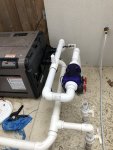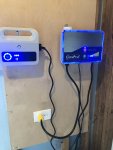Well, as an engineer I assume at sometime in you life you hooked up a DC power supply and an anode and cathode up and made a test tube full of Hydrogen and Oxygen (and if you were me, mixed them together and propelled something with it.) The overall idea of the salt chlorine cell is similar but it controls the reaction by the rare earth metals and how it manipulates the current waveform to make Hydrogen and chlorine gas instead. But just like when, like me, you turned the supply up from 12V to 40V to get the current up and the gas production up, the power draw went up as well (and IIRC not linearly to production either). As a young prospective-at-the-time engineer having the explosion propel the test tube through the suspended ceiling was considered a success but in your pool cell you don't want that to happen, so that is why the flow control/timer shutoff is important!
So since you are forcing a backwards reaction by electrolysis it makes sense the more chlorine you have the cell produce the higher the power requirements.
I am not sure but that likely is another reason to oversize the cell, it likely could be more efficient being oversized. I imagine there is an expert here who will tell me if I am right or wrong. It's actually interesting that these cells don't list a measure of efficiency on them. (Or any useful data for that matter like the size of the darned unit!) What you probably want to compare is your VS pump power consumption versus the cell consumption because you could probably optimize chlorine generation by power and time on if you wanted to, but of course, proper filtration would also come into the equation so the ideal point is the system of all three equations and unknowns...
I would hope your cell does shut down (the flow switch and/or timer) because you don't want that test tube in the ceiling in this case! When it is powered up I imagine it is doing something like a PWM to the cell which is getting averaged out in your kill-a-watt. If it's on you should see power draw. If you are on, drawing current when the water isn't flowing adequately... stop.....

 )
)


